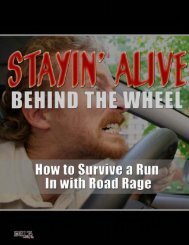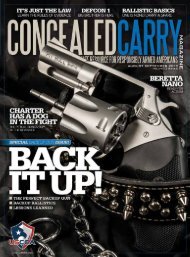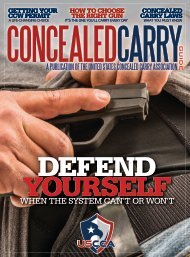Download This Issue - US Concealed Carry
Download This Issue - US Concealed Carry
Download This Issue - US Concealed Carry
Create successful ePaper yourself
Turn your PDF publications into a flip-book with our unique Google optimized e-Paper software.
Caution should be taken should the shooter be on medication<br />
that has side effects.<br />
admit to feeling pain. It takes experience<br />
to be able to see the subtle signs<br />
that something’s not right, and firmness<br />
to insist on “safety first” if necessary.<br />
Assessing all these elements can<br />
be problematic, particularly if the<br />
instructor isn’t experienced in dealing<br />
with them. For this reason, I very<br />
strongly recommend that the first<br />
few training sessions with a disabled<br />
shooter should not involve actual<br />
firearms at all! There are Airsoft<br />
replicas of many modern handguns.<br />
These fire small plastic pellets, which<br />
may sting slightly if they hit someone,<br />
but are unlikely to cause any real injury<br />
(particularly if routine precautions like<br />
the use of protective shooting glasses<br />
are observed). Novice shooters will<br />
handle them with a lot more comfort<br />
than a real gun, and they’re suitable<br />
to teach basic techniques, particularly<br />
safety precautions. If a shooter needs<br />
to work on balance or related issues<br />
while handling a gun, Airsoft replicas<br />
are as safe as it’s going to get for them.<br />
If they fall while using one, they’ll soon<br />
learn how to do so in such a way as not<br />
to trigger a shot–and if they do trigger<br />
one or two in the process, the plastic<br />
pellets won’t cause the same damage as<br />
a bullet.<br />
It’s also a good idea to let the shooter<br />
experiment with different carry<br />
methods while using replica firearms.<br />
That way, they can position holsters<br />
anywhere on their body or their mobility<br />
aid, and try to draw the training<br />
weapon, without fear that they might<br />
accidentally discharge a live round. A<br />
primary carry method can be selected,<br />
and a holster ordered to fit the weapon,<br />
before they ever start shooting “for<br />
real.” <strong>This</strong> removes a great deal of stress<br />
from those unaccustomed to firearms.<br />
Of course, some shooters will become<br />
impatient with “playing around,”<br />
and want to get to “the real thing.” <strong>This</strong><br />
is understandable. I find the best way<br />
to deal with it is to allow them to fire a<br />
few rounds through some of my guns at<br />
the close of each early training session.<br />
They don’t have to draw the gun, as<br />
they’re using a range table; they can sit<br />
down to shoot, if necessary, rather than<br />
try to balance themselves; and there’s<br />
no pressure. They can have a little fun<br />
and slake their appetite for the real<br />
thing while learning the basics in a safe,<br />
controlled manner. By the time they’ve<br />
got the basics right, they will be ready<br />
for a full session with a real firearm.<br />
Finally, initial training sessions are a<br />
good time to select the firearm(s) best<br />
suited to the shooter’s limitations and<br />
level of disability. We’ll discuss this in<br />
detail in the next article in this series.<br />
H<br />
Peter Grant is a retired chaplain, now a<br />
full-time writer. He has been exposed to<br />
conflict situations around the world for<br />
much of his life, and has had to defend<br />
himself against unlawful attack on<br />
more than one occasion. He has trained<br />
disabled and handicapped shooters on<br />
two continents for more than twenty<br />
years. He writes about firearms and selfdefense,<br />
and many other topics, on his<br />
blog at www.bayourenaissanceman.<br />
blogspot.com.<br />
MAY/JUNE 2011 n CONCEALED CARRY MAGAZINE n <strong>US</strong>CONCEALEDCARRY.COM<br />
45
















